The Federal Reserve aggressively raising interest rates, combined with the collapse of Silicon Valley Bank and the sharp increase in office vacancies has led to pressure on regional banks to tighten credit standards, reducing the availability of credit to small and midsize businesses. A deterioration in the capital position of banks leads to a reduction in the supply of credit, causing an increase in the cost of debt finance, the widening of credit spreads and a subsequent reduction in spending and production. The Federal Reserve’s April 2023 Senior Loan Officer Opinion Survey on Bank Lending Practices found:
Significant net shares of banks reported having tightened standards on commercial and industrial loans to firms of all sizes. Major net shares of banks reported tightening standards for all types of commercial real estate loans. Lending standards were tightened for most residential real estate loan categories and for home equity loans. And significant net shares of banks reported having tightened lending standards for credit card, auto and other consumer loans.
As to why banks were tightening credit standards, they frequently cited concerns regarding their liquidity positions, deposit outflows, funding costs, concern for the economic outlook, deterioration of collateral values and deterioration in credit quality of their loan portfolio.
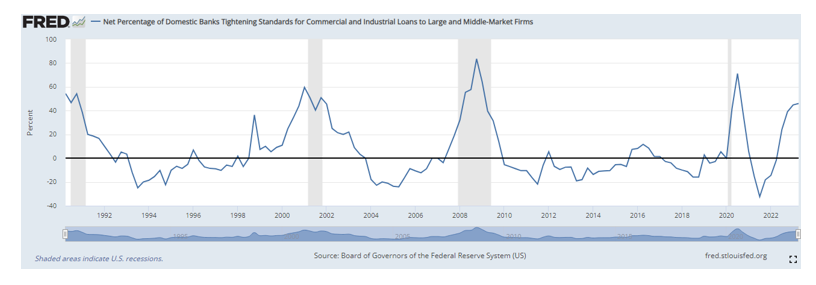
Logically, negative shocks to the cost and supply of credit are likely to lead to significant declines in economic activity and equity prices. The best example is that between the summer of 2007 and the spring of 2009, the U.S. economy was gripped by an acute liquidity and credit crunch (the most severe financial crisis since the Great Depression), leading to a serious recession and a sharp decline in equity prices.
With that in mind, I thought it important to review the literature addressing the question: Do credit spreads provide information on the economy and equity markets? Simon Gilchrist and Egon Zakrajšek sought the answer in their 2011 study “Credit Spreads and Business Cycle Fluctuations,” in which they examined the evidence on the relationship between credit spreads and economic activity. They began by first using prices of individual corporate bonds traded in the secondary market to construct a credit spread index—the ‘GZ credit spread.’ Over their sample period, January 1973-September 2010, they found that the predictive ability of the GZ credit spread for future economic activity significantly exceeded that of widely used default-risk indicators, such as the standard Baa-Aaa corporate bond credit spread and the commercial paper-to-Treasury bill spread. Note that in the chart below, all three credit spreads are clearly countercyclical, rising prior to and during economic downturns:
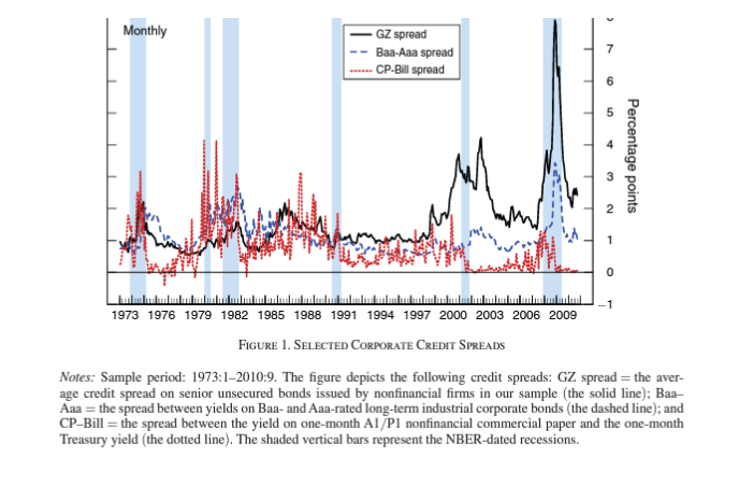
The authors then decomposed the GZ spread into two components: “A component capturing the usual countercyclical movements in expected defaults, and a component representing the cyclical changes in the relationship between measured default risk and credit spreads—the so-called excess bond premium.”
This decomposition was motivated in part by the existence of the ‘credit spread puzzle’—the average price of bearing exposure to U.S. corporate credit risk above and beyond the compensation for expected defaults: “Less than one-half of the variation in corporate bond credit spreads can be attributed to the financial health of the issuer. The unexplained portion of the variation in credit spreads appears to reflect some combination of time-varying liquidity premium, the tax treatment of corporate bonds, and most importantly, a default-risk factor that captures compensation demanded by investors—above and beyond expected losses—for bearing exposure to corporate credit risk.” Here is a summary of their key findings:
The slope of the Treasury yield curve had significant predictive content for all three economic indicators (growth of private nonfarm payrolls, change in the civilian unemployment rate and growth of manufacturing industrial production) at three- and 12-month horizons, with a flat or inverted yield curve signaling a deterioration in labor market conditions and a deceleration in industrial output.
The GZ credit spread was statistically a highly significant predictor of consumption, investment and output at both the short- and longer-term horizons—an increase of 1% in the GZ credit spread in month t implied an almost 3 percentage point (annualized) drop in the growth rate of industrial output over the next three months and a 1.25 percentage point drop in real GDP over the next 12 months.
Negative shocks to the excess bond premium led to economically and statistically significant declines in consumption, investment and output as well as appreciable disinflation—an increase in the excess bond premium of 1% in quarter t led to a drop in real GDP growth of more than 1.5 percentage points over the subsequent four quarters.
The absolute magnitude of the estimated coefficients on the excess bond premium tended to be significantly larger than that of the coefficients associated with the predicted GZ spread—the information content of credit spreads for economic activity largely reflected fluctuations in the nondefault component of credit spreads as opposed to movements in expected defaults. And over the 1985-2010 subperiod, the excess bond premium accounted for all of the predictive content of the GZ credit spread for output growth.
Monetary policy was eased significantly in response to adverse economic developments. However, despite the decline in long-term Treasury yields, such shocks also implied a sharp fall in the stock market.
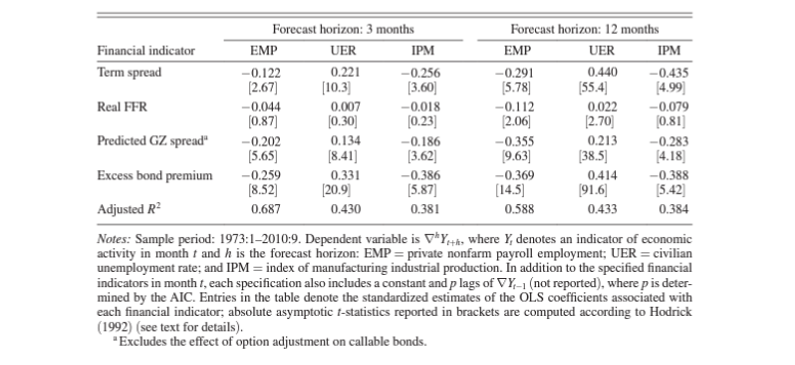
Gilchrist and Zakrajšek explained:
“To the extent that financial disturbances alter risk perceptions in financial markets, changing risk attitudes of the marginal investors pricing corporate bonds may also influence a broader supply of credit. By and large, the corporate bond market is dominated by institutional investors such as large banks, insurance companies, and pension funds, intermediaries that possess specialized knowledge about the corporate bond market and in many cases are highly leveraged. These investors also face either explicit or implicit capital requirements, and as their financial capital becomes impaired, they act in a more risk-averse manner. This reduction in their effective risk-bearing capacity leads to an increase in the excess bond premium and a reduction in the supply of credit available to potential borrowers—both within the corporate cash market and through other sources of external finance.”
The link between the excess bond premium and risk attitudes and balance sheet conditions of financial intermediaries is demonstrated in the chart below, which plots the excess bond premium against the index of the change in credit standards on commercial and industrial (C&I) loans at U.S. commercial banks obtained from the Federal Reserve’s quarterly Senior Loan Officer Opinion Survey on Bank Lending Practices. Note the high correlation:
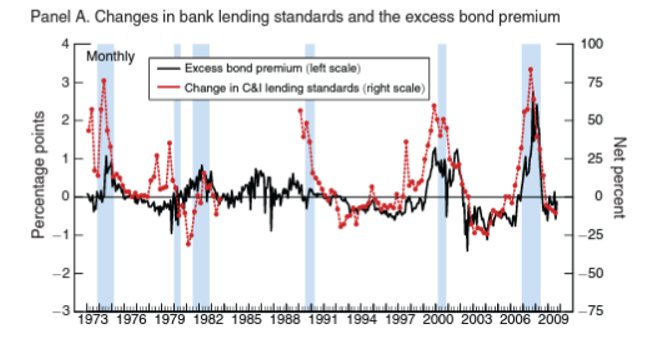
Their findings led Gilchrist and Zakrajšek to conclude: “The confluence of our results is thus consistent with the notion that an increase in the excess bond premium reflects a reduction in the effective risk-bearing capacity of the financial sector and, as a result, a contraction in the supply of credit.” They added: “This reduction in credit availability augurs a change in financial conditions with significant adverse consequences for macroeconomic outcomes.”
Supporting Evidence
Gilchrist and Zakrajšek’s findings are consistent with those of the author of a 2006 Federal Reserve Bank of Atlanta study who found that credit standard tightening shocks were associated with substantial declines in output and in the capacity of businesses and households to borrow from the banking sector, as well as a sharp widening of credit spreads. The result is that GDP growth declined significantly within two quarters.
The authors of the 2012 study “Changes in Bank Lending Standards and the Macroeconomy” similarly found that “an adverse loan supply shock of one standard deviation is associated with a decline in the level of real GDP of about 0.75% two years after the shock, while the capacity of businesses and households to borrow from the banking sector falls almost 4% over the same period. This shock also leads to a substantial rise in private credit spreads.” Eventually, the economic effects of the deterioration in the supply of credit elicit a significant easing of monetary policy.
The empirical research demonstrates that changes in bank lending standards provide information on future economic growth and stock returns. Linus Wilson’s 2023 study “Profitable Timing of the Stock Market with the Senior Loan Officer Survey” found that the loan standards question in the Fed’s Senior Loan Officer Survey is a significant predictor of the S&P 500’s quarterly stock returns and that an asset manager could put on stock trades a month or two after the survey is released and earn abnormal returns with reduced volatility.
Hai Lin, Xinyuan Tao, Junbo Wang and Chunchi Wu, authors of the 2020 study “Credit Spreads, Business Conditions, and Expected Corporate Bond Returns,” demonstrated that the GZ spread not only provided insights into economic conditions and future stock market returns but also future corporate bond returns over both short and long horizons.
Investor Takeaways
Economists have long known that tightening of credit conditions foreshadows weaker economic growth, increasing the likelihood of a recession. However, what is likely to surprise most investors is that the empirical evidence, as seen in the table below, shows that average U.S. equity returns have been positive after the onset of a recession:
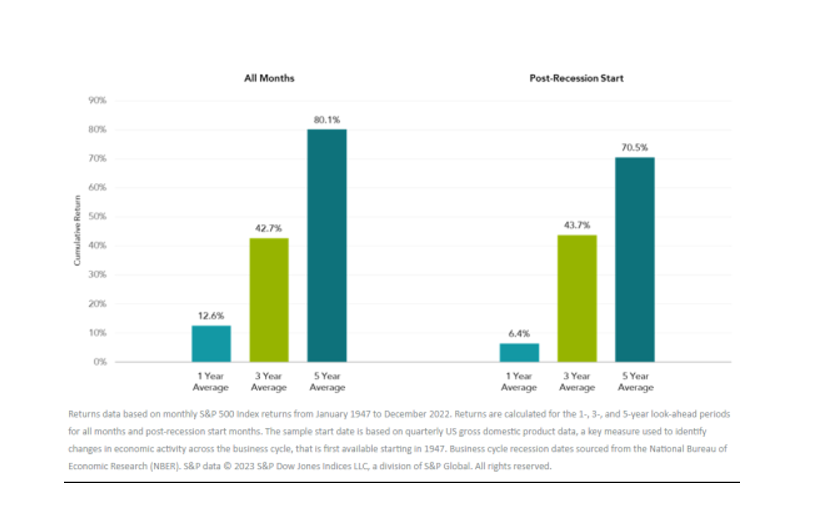
That returns have been positive and similar in both sets of data is consistent with the theory that markets are forward-looking. Even with the benefit of hindsight, and ignoring expenses and taxes, there isn’t much evidence to support a timing strategy based on a recession forecast. With that said, Gilchrist and Zakrajšek and Wilson showed that tightening conditions also had predictive value for future stock returns.
Armed with this information, investors already concerned about the high valuations of broad market indices, such as the S&P 500, and the increasing risks of recession might be considering lowering their equity allocation or even getting out of stocks altogether.
Before making that decision, consider that the literature shows that publication of research on future stock returns leads to a decline in premium returns—or even their elimination (if there is no risk-based explanation for the abnormal returns). Since all the findings we have reviewed are public, that brings into question their future value.
In addition, since the Great Recession there has been a dramatic shift in the credit markets, with private credit stepping in and taking significant market share, replacing banks as lenders to smaller and mid-size businesses. Private credit has grown quickly, reaching $1.4 trillion of assets under management globally at the end of 2022, up from about $500 billion in 2015, putting it on par with the U.S. junk bond market. Thus, banks tightening credit standards might not have the same effect on the economy going forward.
Larry Swedroe has authored or co-authored 18 books on investing. His latest is Your Essential Guide to Sustainable Investing. All opinions expressed are solely his opinions and do not reflect the opinions of Buckingham Strategic Wealth or its affiliates. This information is provided for general information purposes only and should not be construed as financial, tax or legal advice.





